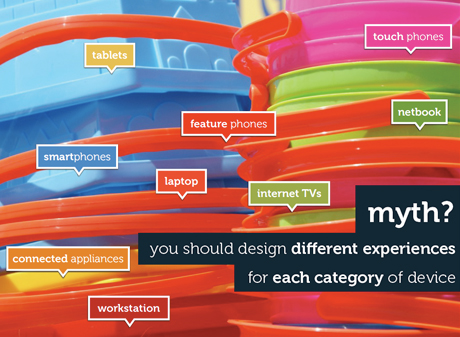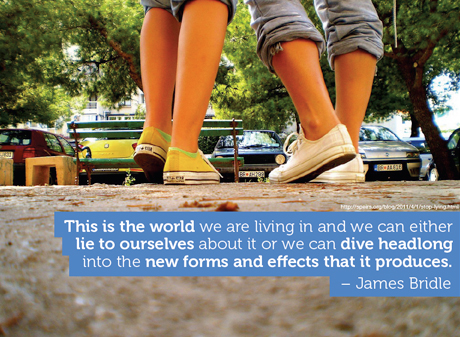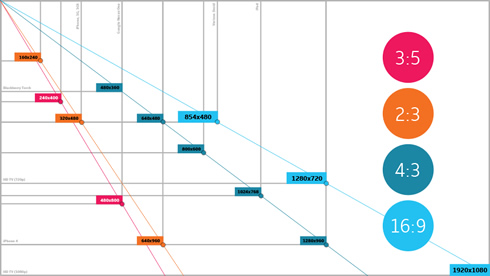The 25 year evolution of the mobile phone pic.twitter.com/cRC65oStIk
— Vala Afshar (@ValaAfshar) June 28, 2015
Tag: device
The Power of Mobile Web for Tourism
Nice presentation by Stephanie Rieger
Buttons are a Hack: The New Rules of Designing for Touch
“Fingers and thumbs turn design conventions on their head. Touchscreen interfaces create ergonomic, contextual, and even emotional demands that are unfamiliar to desktop designers. Find out why our beloved desktop windows, buttons, and widgets are weak replacements for manipulating content directly, and learn practical principles for designing mobile interfaces that are both more fun and more intuitive. Along the way, discover why buttons are a hack, how to develop your gesture vocabulary, and why toys and toddlers provide eye-opening lessons in this new style of design.” – Josh Clark
It’s about people, not devices
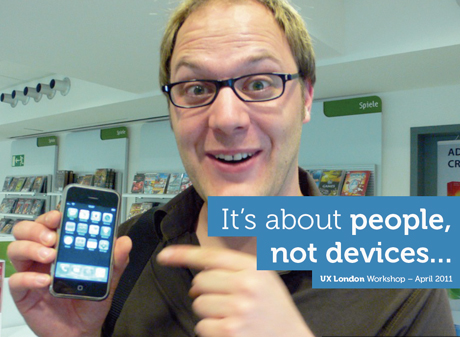
We live in exciting times. Times of innovation, invention, and rapid change. Technologies that were unthinkable years ago are now commonplace. Close to 1.5 billion people worldwide use a computer, but that figure pales in comparison to the 4.2 billion (75% of the planet) who use or have access to a mobile phone.
Presentation by yiibu, download here Via UXbooth
Pixel Proliferation: A Toolset For Managing Screen Resolutions
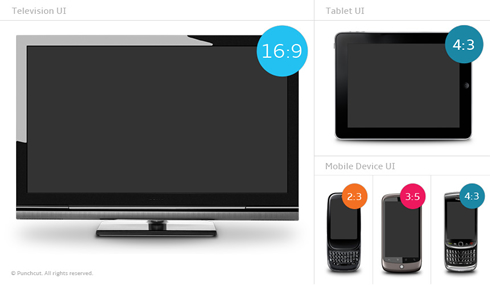
Change is a constant. The device landscape for which we design is always changing and the device types are always proliferating. And with the increasing demand for unique mid-screen devices, it is becoming an even more arduous task to keep things straight.
Few Design Considerations:
- Every device is unique.
- Build for a human scale.
- Test your design on the target device.
Via Punchcut, download the toolset &Â reference chart.
Worlds first mobile Augmented Reality browser
I am impressed with the new features and how augmented reality is taking place in our daily life, just not only for browsing information’s but also from trying new dresses to getting your new hair style done!, another very recently Google also released Google Goggles, a visual search app for Android phones. it’s just couple of examples but you can think of as many ideas you can!
Go through the above video examples of augmented reality in real time, you will see how it makes your life easy. 🙂
What you think about it?
vivek
Actface Rhythm: Mobile Interface design
Act face is a mobile device interface designed by “Teamlab” to create new contents using meta information of users behaviors.!
Some user behaviors like:
- You become addicted to your mobile device, As its screen changes and as you use it more, it adapts to your situation.
- You feel good touching your mobile device, Simply pressing the keys is fun in itself, And you keep wanting more. You start to enjoy the interaction with your mobile device, And it changes the purpose of using the phone, just touching the phone brings you enjoyment.
- How many times will you open it. To see if any changes have occurred Will you ever be able to let go of your phone?…
- You feel good touching your mobile phone, everyday use of your phone become a rhythm, a phone with a surface of rhythmic ink painting.
Concept:
Actface Rhythm is not a phone designed to produce music, but a phone that produces an internal rhythm, a moving image that is produced through the everyday use and the rhythm of pressing the keys. We regularly press keys to make a call, and to send a mail, and we considered this to be a natural rhythm. We designed actface Rhythm’s interface to produce an ink painting world that is created by the user, and as the phone is used the ink painting continues to develop and move with the rhythm you create.
“This is not just a new screen design, By adding a secondary purpose in using the phone, we have experimented in a new style of interaction between human and mobile devices.”
Very interesting concept !!
vivek
Video: Introduction to Adobe’s mobile packager
A step by step video tutorial of Adobe’s mobile packager for distributing your Flash lite content by Serge Jespers.
“you can now package your application using the Mobile Packager and distribute your application as an SIS-file for Symbian S60 or CAB-file for Window Mobile phones. Your users can now download and install your Flash based application on their mobile device just like any other application they install. What’s even cooler is that we also package a Flash Version Checker together with your application. As soon as the user launches the application, the Flash Version Checker is going to check if the Flash Player is installed and if it is the correct version. If not, it’s going to download and install the Flash Lite runtime seamlessly.”
Unfortunately this packager works only on Windows and i hope adobe may release Mac version soon!!!
Very cool.
vivek
New Adobe eSeminar on Flash Lite Mobile Gaming, Device Central CS 4, Nokia Series 40
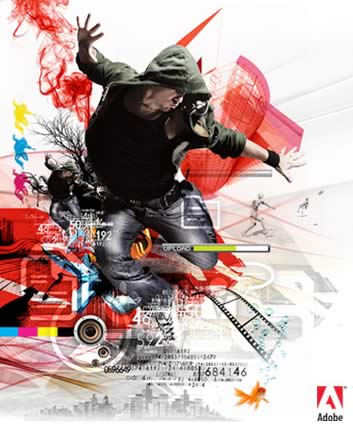
Via adobe, three new seminars announced in during october and november on Flash Lite Mobile Gaming, Device Central CS 4, Nokia Series 40.
Mobile eSeminars
- Adobe Device Central Creative Suite 4
Speaker: Dale Rankine
Wednesday 29 October 2008 2:00PM Australian EDT
- Adobe Flash Lite Mobile Gaming
Speaker: Dale Rankine
Wednesday 12 November 2008 2:00PM Australian EDT
- Adobe Flash Lite and Nokia Series 40
Speaker: Dale Rankine
Wednesday 26 November 2008 2:00PM Australian EDT
vivek
Nokia 5th edition with New device API for Flash lite :)
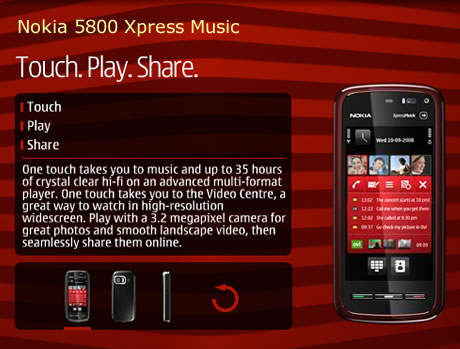
Finally something must to be excited about for Flash lite developer, Nokia released new Device API support for Nokia S60 5th Edition where it can access to Phone features.
Developers of Flash Lite from Adobe applications benefit from the UI enhancements in S60 5th Edition, with more screen real estate and touch interaction enabling users to more easily and intuitively navigate Flash Lite content and applications. The on-screen keyboard also is available for text and data entry.
S60 5th Edition continues to support Flash Lite 3.0, with the addition of ActionScript extensions to take advantage of S60 Platform Services.
These extensions provide access to:
- The application manager.
- Calendar records.
- Contacts records.
- Log information.
- SMS and MMS messaging.
- The media gallery.
- Device location.
- Landmarks.
- System information.
- Sensors.
These new APIs enable Flash Lite developers to access device-application data, such as that held in Calendar and Contacts, as well as information on a device’s location.
Together, the UI- and platform-access enhancements enable Flash Lite developers to create a completely new breed of context-aware applications and services that provide users with information unique to their own experiences.
First device with S60 5th Edition is Nokia 5800 Xpress Music
vivek
A Cross Cultural Study on Phone Carrying “Where’s the Phone?”
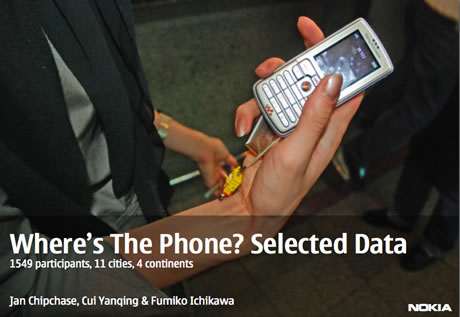
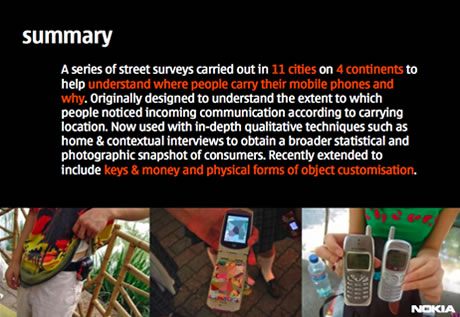
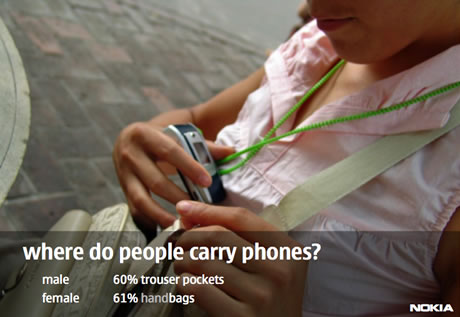
I found this very intresting research paper a Cross Cultural Study on Phone Carrying and Personalisation co-authored by Cui Yanqing and Fumiko Ichikawa which is presented at HCI International 2007 in Beijing.
This essay presents data from a series of Nokia street surveys conducted between 2003 and 2006 that explored where people carry their mobile phones and why?
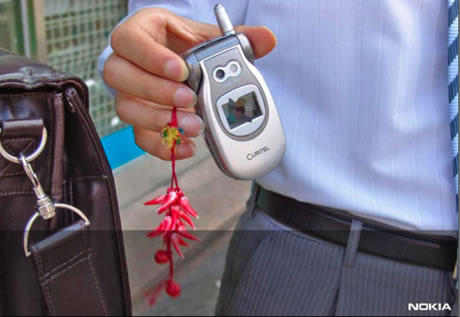
“Where’s the Phone street surveys set out to document the extent to which people noticed their incoming communication and cross refererence this information to the location where the phone is carried. The mobile phone’s effectiveness as a communication device is partly dependent on its owner noticing incoming communication (though whether someone decides to respond to that communication is another matter entirely) and it was assumed by the authors that the process of deciding to carry an object would correlate with a minimal level of its effective use. Contexts where there was a high likelihood of missing incoming communication presented a design opportunity both in terms of thinking about device redesign and from the perspective of connectivity-related services accessed through that device.
Download this pdf here as powerpoint or pdf (3MB).

Read as from Jan Chipchase here.
View results of this research paper here
Very Interesting . .
vivek

